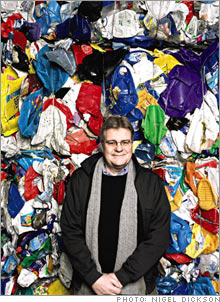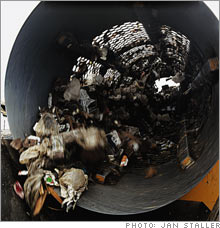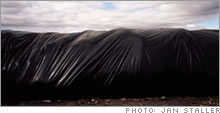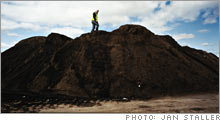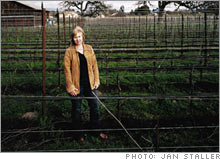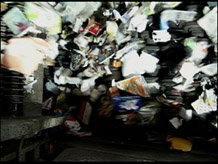The end of garbageCan you imagine a world of zero waste? Cities and towns across the world - and a surprising number of companies - have adopted that goal, says Fortune's Marc Gunther(Fortune Magazine) -- "Garbage," says the character played by Andie MacDowell in Sex, Lies, and Videotape. "All I've been thinking about all week is garbage. We've got so much of it, you know? I mean, we have to run out of places to put this stuff eventually." In 1989, America had garbage on its mind. A barge called the Mobro had carried 3,000 tons of unwanted trash up and down the East Coast. California told its cities to recycle 50% of their garbage by 2000 or face steep fines. The national recycling rate was only 16%.
Today San Francisco has a recycling rate of 68%, the best of any American city, and it intends to do better. Much better. San Francisco and Wal-Mart (Charts) do not have much in common, but there is this: Both have a goal of achieving zero waste. So do cities and towns from Boulder and Carrboro, N.C., to Buenos Aires and Canberra, as well as a surprising number of businesses, including Toyota (Charts), Nike (Charts), and Xerox (Charts). They're making headway: Toyota has eliminated all the waste from its 5,000-employee U.S. headquarters near Los Angeles. Governments, meanwhile, are stepping in to regulate the disposal of computers, cellphones, and packaging. Zero waste is just what it sounds like - producing, consuming, and recycling products without throwing anything away. Getting to a wasteless world will require nothing less than a total makeover of the global economy, which thinkers such as entrepreneur Paul Hawken, consultant Amory Lovins, and architect William McDonough have called the Next Industrial Revolution. They want industry to mimic biology, where one species' excrement is another's food. "We're not talking here about eliminating waste," McDonough explains. "We're talking about eliminating the entire concept of waste." This utopian vision is a long way off. But the changing economics of waste disposal, technical advances, and grass-roots activism - along with the feverish desire of big companies to appear green - are bringing it closer than you might think. San Francisco offers a glimpse of the future. Norcal Waste Systems, the city's trash hauler, provides customers with color-coded 32-gallon carts known as the Fantastic Three - a blue cart into which they can throw paper, glass, plastics, and metal for recycling; a green cart for food and yard waste; and a black cart that's destined for the landfill. (Remember, in cowboy movies the bad guys wore black.) Norcal also recycles tires, mattresses, and light bulbs. "The other garbage companies think we're nuts," says Mike Sangiacomo, Norcal's CEO. Sangiacomo, 58, has been trash-talking for years. His dad collected garbage back in the days when sanitation men were called scavengers because they salvaged bottles, rags - "anything they could come up with that had value," he says. Now he's trying to return the waste industry to its roots. Technology is a big help. Norcal operates a $38 million facility that disaggregates all the recyclables in those blue bins. Conveyor belts, powerful magnets, and giant vacuums separate computer paper from newsprint, plastic jugs from water bottles, and steel and tin cans from aluminum. Materials are then sold to global commodity markets - and we do mean global. Wastepaper, for example, is the U.S.'s No. 1 export by volume to China, according to PIERS Global Intelligence Solutions, which tracks trade. Ships that bring products from China to the U.S. return with wastepaper, which becomes packaging for goods made in China. A second innovation is the city's handling of food scraps. Another Norcal facility grinds all that up with yard waste and cures it for three months. Banana peels, onion skins, fish heads, and other detritus are thus transformed into a nutrient-rich product dubbed Four Course Compost, which sells for $8 to $10 per cubic yard. One satisfied customer is winemaker Kathleen Inman, who knows that all good wine - her 2004 Olivet Grange pinot noir retails at $42 a bottle - begins in good soil. She spreads Four Course Compost on her ten-acre vineyard in Sonoma County's Russian River Valley. "I was very taken by the concept of bringing into my vineyard what would normally go into a landfill," Inman explains. "When someone enjoys the wine at a table, they are completing the recycling circle." Driving this virtuous cycle are market incentives. San Franciscans get about $5 off the standard $22-a-month collection rate if they can make do with a smaller black bin, sending less to the landfill. Merchants earn discounts for recycling, and Norcal gets bonuses for keeping waste out of landfills. Jared Blumenfeld, director of the city's environment department, says, "The most important thing we do is incentivize people financially to do the right thing and make it more expensive for them to do the wrong thing." This "pay as you throw" pricing scheme drives up recycling rates sharply, studies show. But only about 20% of Americans pay for trash collection based on how much they discard. No wonder we're an effluent society. While the concept of zero waste is as old as nature, recycling is newer. In 1968, Madison, Wis., became the first U.S. city to offer curbside recycling, for newspapers. Recycling got a boost with Earth Day in 1970, and again after the EPA imposed strict regulations on landfills in 1991. When done right, recycling saves energy, preserves natural resources, reduces greenhouse-gas emissions, and keeps toxins from leaking out of landfills. So why doesn't everyone do it? Because it's often cheaper to throw things away. The economics of recycling depend on landfill fees, the price of oil and other commodities, and the demand for recycled goods. Paper, for example, works well: About 52% of paper consumed in the U.S. is recovered for recycling, and 36% of the fiber that goes into new paper comes from recycled sources. By contrast, less than 25% of plastic bottles are recycled, and we use five billion (!) a year. Americans generated an average of 4.5 pounds of garbage per person per day in 2005, the EPA reports. About 1.5 pounds were recycled. That's a national recycling rate for municipal solid waste of just 32%. What's in our garbage? Paper and cardboard (34%), yard trimmings (13%), and food scraps (12%) are the three biggies. All can be easily if not always profitably recycled. Plastics (11.8%) are next, and are harder to recycle. "The plastics industry hasn't been as interested as others in working through its problems," says Gary Liss, a California zero-waste consultant. "They have fought bottle bills all over the country for 30 years." Bottle bills are an example of "extended producer responsibility," a key tenet of zero-waste. It puts the onus for safely disposing of products on the companies that make them. Yes, it's a controversial concept. (In this country. In the EU, makers of household appliances are obliged to take them back.) The deeper purpose here is to change the way things are made. "From our perspective, waste doesn't need to exist," says San Francisco's Blumenfeld. "It's a design flaw." Carpet companies Interface, BASF, and Milliken, furniture makers Herman Miller and Steelcase, and clothing firms Nike and Patagonia have all redesigned products to make them easier to recycle. Over time the economics of recycling should improve. The costs of virgin commodities are likely to rise as supplies dwindle; fees will climb at landfills as they fill up. Landfills also release methane, a greenhouse gas that could be taxed because it contributes to global warming. Meanwhile, recycling has become a $238 billion business, employing 1.1 million people, according to the EPA. Despite all that, recycling rates have flattened lately. "We have to reengage the consumer," says Kate Krebs, executive director of the National Recycling Coalition, a trade group whose board includes executives of Dell (Charts), Coca-Cola, and Time Inc. (Fortune's parent company). "If we don't, then all the commitments that Wal-Mart and Dell and others have been making will be difficult to keep." A Hewlett-Packard (Charts) executive named Rene St. Denis went to China in 1994 to see what happened to printers and computers after they were thrown away. In the coastal city of Guanjo, she watched hundreds of people smash machines to get at the metals inside. "The disassembly process was basically - and I'm not kidding - hit it with a rock," she recalls. "You pay someone $2 a day to strip away $3 worth of copper, and it's a pretty good business." It's also a dangerous business because computers may contain toxic materials such as lead, mercury, and cadmium. Within a year St. Denis had begun to clean up HP's act. She helped form a partnership with a Canadian metals and mining firm called Noranda to build a recycling facility near Sacramento. Here, old printers and PCs come to die: After technicians recover reusable parts, the machines are chopped up by powerful shredders, smashed to bits by a granulator, and sorted by magnets and air currents. Precious metals go to Noranda; aluminum, glass, and plastic are sold to recyclers. Nothing goes to landfills. HP provides free recycling to some customers but charges others $13 to $34 per item. Even so, HP's recycling operation runs at a small loss, which is viewed as an investment in the firm's reputation and values. "To the degree they understand, customers have a better view of HP," says St. Denis, who now runs HP's recycling business. As HP set the pace, Dell became a target. Because Dell used prison labor to recycle PCs, protesters picketed a speech by Michael Dell at the Consumer Electronics Show in 2003. The company began offering recycling: first to buyers of new equipment, then to anyone willing to pay $30, then $15. Last year it eliminated the fees altogether - the only PC maker to do so. In January at CES, Michael Dell said, "I challenge every PC maker to join us in providing free recycling for every customer in every country all the time. No exceptions." |
Sponsors
|

